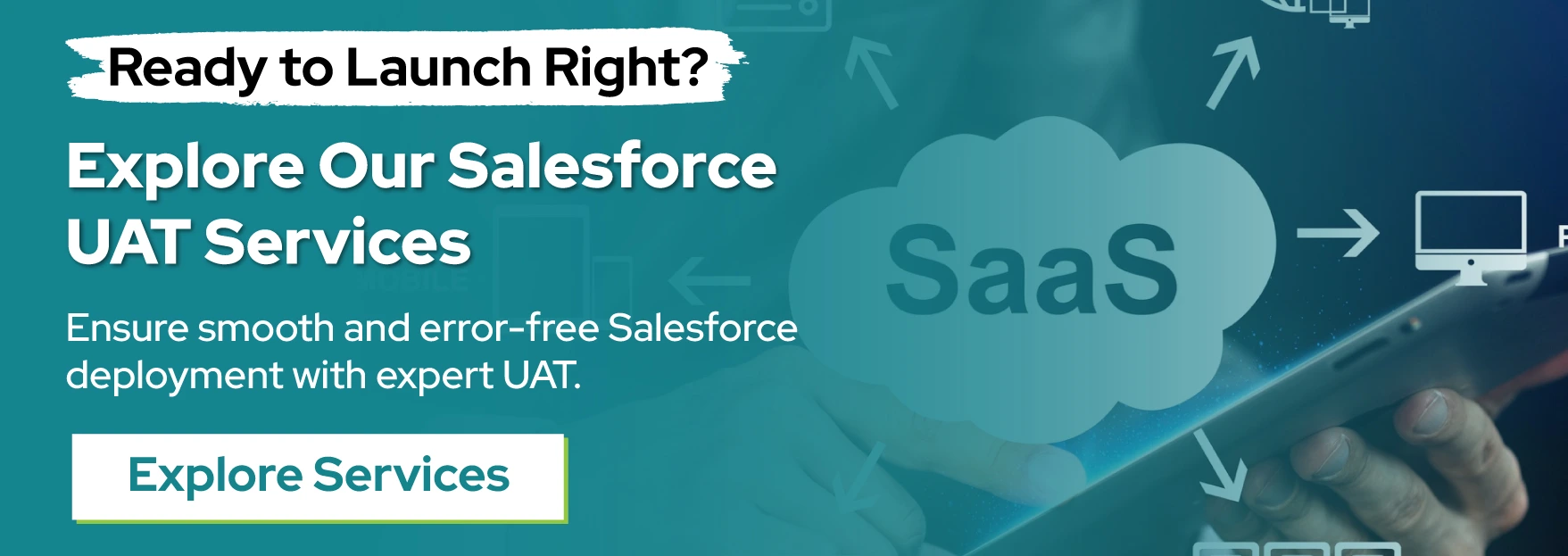Salesforce is the biggest investment for any company’s success. It’s not a tool for managing clients but for the growth of your firm’s success. The ideal salesforce ecosystem enhances sales effectiveness, boosts employee productivity & minimizes the time to close deals. Salesforce delivers vast features that boost organizational growth.
The key to achieving success is robust adoption by the end business users. Based on the report, 70% of CRM projects fail during implementation, and that’s why testing is necessary before implementation. Salesforce is a robust CRM platform delivering unique features that keep it different from the CRM tools.
UAT is similar to functional testing services involved in SDLC, where the clients and end users test the application to make sure it’s ready for release. This is also popular as end-user or beta testing. UAT is the final step in SDLC prior to deployment. The aim is to verify that the software matches all requirements & all functions are expected.
UAT aims to track validation of business process & needs rather than spotting the design errors & system functionality errors. In the following blog, you can learn about various types of Salesforce UAT, along with real-world examples. In addition, cover the best practices for the UAT process while implementing Salesforce.
What is User Acceptance Testing (UAT)?
UAT is a procedure that evaluates a product’s usability from the perspective of the user or consumer. Since it’s the last testing phase, your product will have already undergone a bug check. Before a particular version of the CRM is put into production, Salesforce UAT confirms that it satisfies the relevant business requirements.
In order to ensure a successful and seamless deployment, this stage assists in identifying any gaps or problems that need to be fixed. You may interact with the product and assess its functioning through UAT testing, which closely resembles real-world usage scenarios. This testing procedure may be used for software updates, integrations, and modifications in addition to new software creation.
Before deployment, it’s necessary to validate requirements, check functionality, and evaluate usability through UAT testing. To guarantee a successful software launch, UAT also assists in identifying flaws and reducing risks. It will be far more expensive to fix any issues after release if you avoid UAT. So, overall, it will save you a lot of time and money.
Why UAT is Critical for Salesforce Deployments
❖ Ensures business requirements are met
UAT makes sure the implemented solution satisfies user expectations and business objectives prior to going live. UAT verifies that the system is usable, satisfies the demands of actual end users, and operates as anticipated. It assists in finding any problems that may have gone unnoticed and verifies that the Salesforce implementation is prepared for practical application.
❖ Reduces post-deployment issues
By confirming that the system satisfies user expectations and business objectives before going live, UAT greatly lowers post-deployment difficulties in Salesforce installations. UAT reduces the chance of expensive repairs and post-deployment interruptions by incorporating end users in the testing process to help find and correct problems early.
❖ Improves user confidence and adoption
Through direct user participation in the testing process, UAT increases user confidence and adoption, resulting in the identification of usability issues, confirmation of business needs, and a sense of involvement among users. Early problem solving reduces post-launch problems, improves user happiness.
❖ Aligns technical outputs with business expectations
After all technical development and testing stages by a functional testing company, UAT makes sure the program still meets user demands and business objectives. UAT helps create a more seamless and satisfying user experience by verifying the software’s usability and functionality. UAT essentially serves as a vital link between technical development and business objectives, guaranteeing that the end result is both technically perfect and satisfies users’ expectations and needs in the real world.
Also Read : The Importance of Salesforce Integration Testing for Optimized Business Operations
Preparing for a Successful UAT
1. Define Clear Objectives
Setting precise UAT goals is essential to coordinating testing activities with corporate objectives. The goal should make it clear what success looks like and guarantee that the salesforce implementation goes well with the desired business results. Determine the essential features end users depend on and evaluate how well they work.
Setting effective and realistic goals can be facilitated by early stakeholder involvement. Effective resource allocation and testing efforts that stay in line with project goals are guaranteed by a well-defined scope. Create test scenarios using the use case, & flow charts as a guide. These publications guide the development of customized test scenarios that meet the needs of your project.
2. Assemble the Right Team
You may hire functional testing company testers to test the Salesforce solution before implementation. Focus on choosing people who are actual end users of the system or who have in-depth knowledge of Salesforce and the business needs when choosing the ideal team for Salesforce UAT testing. To give thorough feedback and assistance, make sure the team has a variety of jobs and responsibilities, such as software engineers, project managers, testers, and company owners.
3. Create Comprehensive Test Plans
Clear documentation must be established before user acceptability testing begins in order to guarantee stakeholder alignment. UAT documentations that are well-structured offer a road map for the testing procedure, outlining goals, roles, and expectations. Maintaining everyone’s alignment with the same goals and vision may be achieved by developing a UAT test strategy.
It contains all the details on what will be examined, by whom, and how, because it is the primary document. You must describe the testing approach and entry/exit criteria in detail in order to cover all organizational and procedural components of UAT. The Salesforce testing strategies must include testing type, outcomes, testing objective & scopes, etc.
Key Steps in Executing Salesforce UAT
1. Set Up a Dedicated UAT Environment
UAT for the Salesforce solution requires a specific test environment. Before moving forward, it’s crucial to confirm that Salesforce’s license agreements allow for the creation of testing sandboxes. After creating a sandbox and adding test data, assign the proper user roles and permissions. For testing to be successful, the sandbox environment must closely resemble the production configuration.
When the sandbox is not correctly linked with production, for example, some organizations may initially experience problems with data integrity or configuration incompatibilities in their Salesforce solution. Teams may reduce the chance of problems after launch by doing more accurate and efficient testing by adjusting the sandbox parameters to more closely resemble the real-world environment.
2. Develop Detailed Test Scripts
Create test cases with explicit procedures after identifying test scenarios from business procedures. Focus your UAT testing on UI/UX and/or functional issues. Verify that all of the components, drop-down menus, and buttons work as intended. Make sure scrolling isn’t hampered by any overlapping components. Verify that every CSS style renders properly and doesn’t make it difficult for users to navigate the application.
3. Train UAT Participants
Focus on offering thorough training materials, practical sessions, and continuous assistance in order to prepare UAT participants for Salesforce. This refers to choosing representative users, providing accurate training, creating open lines of communication, and precisely outlining the objectives and scope of the UAT.
4. Conduct UAT Sessions
Analyzing business needs and goals, developing a thorough UAT strategy, establishing test scenarios and cases, generating realistic test data, carrying out tests and monitoring outcomes, and verifying that company objectives are fulfilled are the first steps in conducting Salesforce UAT sessions successfully.
After that, a feedback loop will be created between developers and testers to resolve any problems found throughout the UAT phase. This entails establishing a test environment, defining the scope, educating users, and recording every step of the procedure.
5. Capture and Track Feedback
Encourage end users to take an active part in testing and provide their opinions on usability and functionality. Ask users to run the test cases and record any problems or inconsistencies. Defects will be found and fixed using this data. Establish a conduit for testers to communicate with developers so that problems may be found and fixed quickly. All feedback, including problems, bugs, and recommendations, should be recorded using a UAT tracking tool, such as a third-party program or the built-in features in Salesforce.
6. Prioritize and Resolve Defects
The primary goal of any functional testing service provider is to identify problems and their underlying causes that could hamper Salesforce CRM’s ability to operate effectively. Tests can identify setup problems or broken lines of code that testers must promptly fix. Prioritizing and fixing bugs is part of Salesforce UAT (User Acceptance Testing), which makes sure the platform satisfies business needs prior to deployment.
7. Re-Test and Validate Fixes
Make sure that the fixes fulfil the business requirements and address the issues that have been reported. To make sure the problems are fixed, retest the components where changes were applied. Get final user feedback to move forward with the deployment once all problems have been fixed and the remedies have been verified. Give end users thorough training and documentation so they can utilize Salesforce efficiently.
Also Read : The Future of QA Outsourcing: Meeting Industry-Specific Needs with KiwiQA Expertise
Best Practices for Salesforce UAT
❖ Start UAT early in the project lifecycle
If QAs from a functional testing company are involved early in the SDLC, they will have more time to test the Salesforce platform. As a result, testers will have more time to conduct testing, which will increase the variety and coverage of Salesforce tests carried out. The influence on a project’s final outcome decreases with the amount of time needed to detect the issue.
Testing is only guaranteed during the development stage, not after deployment. Frequent testing also guarantees continuous system integrity during Salesforce customization cycles and updates. It will be beneficial to test early & frequently in order to detect integration problems, workflow disruptions, and configuration errors before experiencing any errors.
❖ Involve real end-users, not just testers
To make sure the UAT procedure is as realistic as feasible, including end users who will use the system on a regular basis. End users should actively engage in testing real-world scenarios and offer insightful feedback as part of a collaborative effort. This guarantees that the solution satisfies their real requirements and detects any possible usability problems before implementation.
❖ Keep communication channels open
Create frequent lines of communication and plan updates to give information to every party and address any problems that may arise. Using daily stand-up meetings during UAT is one of the best practices to make sure that any problems are discussed and resolved quickly, keeping the project on schedule. To monitor UAT progress, test outcomes, and problem-solving, use standardized reporting formats. Plan frequent meetings and provide progress reports to everyone involved.
❖ Document everything (issues, approvals, changes)
Documentation is essential to the effectiveness of Salesforce UAT. To guarantee accountability and traceability, record test cases, data, expected & real results. To record concerns, set priorities, and keep an eye on the resolution process, use a defect tracking system. Effective problem solving and knowledge transfer are made possible by thoroughly documenting every step of the process, from test designs and models to test data and outcomes.
❖ Celebrate UAT completion to encourage adoption
Thorough UAT should be prioritized, and its completion should be celebrated, in order to effectively deploy Salesforce and promote user acceptance. Real end users should be included in UAT, actual test data should be used, and automation should be used wherever feasible.
By adhering to these best practices, businesses can guarantee a successful UAT process, which will improve their Salesforce deployment results and increase user acceptance.
Ready to Launch? Let’s Ensure Your Salesforce Deployment is a Success
To make sure that your customized Salesforce functional testing service provider fits the particular requirements of your company, Salesforce UAT is crucial. The UAT procedure needs to be carefully done in order to succeed. Your process may be streamlined by following best practices, which include using the appropriate testing tools, prioritizing fixing bugs, and incorporating actual end users. You may streamline your UAT procedure and make sure that your Salesforce deployment satisfies the requirements of your business users by adhering to these best practices.



